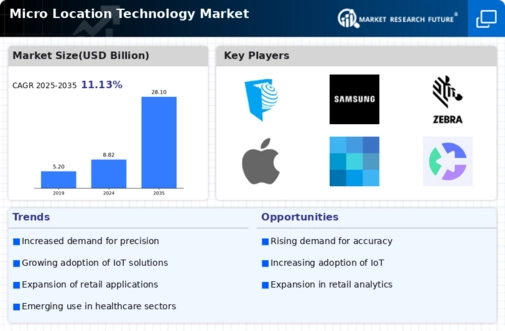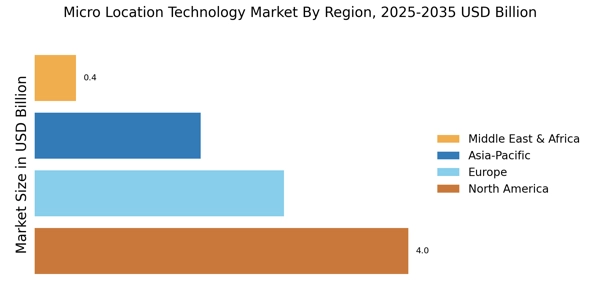Growth of Smart Cities
The Micro Location Technology Market is significantly influenced by the ongoing development of smart cities. As urban areas evolve, the integration of micro location technologies becomes essential for efficient resource management and enhanced public services. These technologies facilitate real-time tracking of assets, optimize traffic flow, and improve public safety. Reports indicate that investments in smart city initiatives are expected to exceed USD 1 trillion by 2025, highlighting the potential for micro location technology to play a pivotal role in urban planning and infrastructure development. This growth underscores the increasing reliance on advanced technologies to create sustainable urban environments.
Enhanced Customer Experience
The Micro Location Technology Market is witnessing a surge in demand as businesses increasingly prioritize enhanced customer experiences. By leveraging precise location data, companies can tailor services and promotions to individual preferences, thereby fostering customer loyalty. For instance, retailers can send personalized offers to customers' smartphones as they enter a store, creating a more engaging shopping experience. According to recent estimates, the market for location-based services is projected to reach USD 40 billion by 2026, indicating a robust growth trajectory. This trend suggests that businesses are recognizing the value of micro location technology in driving customer satisfaction and retention.
Rise of Location-Based Marketing
The Micro Location Technology Market is experiencing a notable rise in location-based marketing strategies. Businesses are increasingly utilizing micro location data to target consumers with relevant advertisements based on their real-time locations. This approach not only enhances marketing effectiveness but also improves return on investment. Recent studies suggest that location-based marketing can increase customer engagement rates by up to 30%. As companies seek to optimize their marketing efforts, the demand for micro location technology is likely to grow, reflecting a shift towards more personalized and context-aware advertising strategies.
Advancements in Beacon Technology
The Micro Location Technology Market is benefiting from advancements in beacon technology, which enables precise indoor positioning and proximity marketing. Beacons, small wireless devices that transmit signals to nearby smartphones, are increasingly being adopted across various sectors, including retail, hospitality, and healthcare. The Micro Location Technology Market is projected to reach USD 25 billion by 2025, indicating a strong growth potential. This technology allows businesses to engage customers in real-time, providing them with relevant information and offers based on their specific locations within a venue. As beacon technology continues to evolve, its integration into micro location solutions is expected to drive further innovation.
Increased Demand for Asset Tracking
The Micro Location Technology Market is witnessing an increased demand for asset tracking solutions across various sectors. Organizations are recognizing the importance of real-time visibility into their assets, which can lead to improved operational efficiency and reduced costs. Industries such as logistics, manufacturing, and healthcare are particularly benefiting from micro location technologies that enable precise tracking of equipment and inventory. Market Research Future indicates that the asset tracking market is anticipated to grow to USD 30 billion by 2027, reflecting a strong trend towards adopting technologies that enhance supply chain management and operational transparency. This demand is likely to propel the growth of micro location technology solutions.


















Leave a Comment